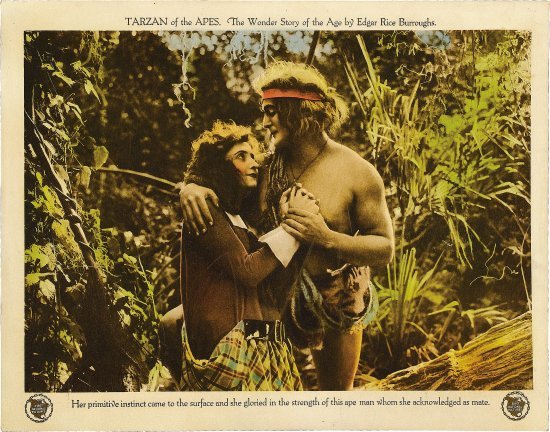One hundred years ago, the still relatively new and uncensored Hollywood film industry produced many exciting titles, including Tarzan of the Apes, the first film adaptation of Edgar Rice Burroughs’ 1912 novel of the same name.

Reproduced from http://www.erbzine.com/mag5/0503.html
The silent feature was directed by Scott Sidney and starred Elmo Lincoln, best remembered as the original Tarzan. Jane was played by Enid Markey, who is also best known for this film.
American audiences enthusiastically received the feature. Viewers were astonished by images of the “jungle” and "wild animals", seemingly providing a window into a "foreign land". In reality, the production mostly took place in Hollywood and Louisiana. Many of the featured animals were actually humans in costumes. Still, however, Tarzan capitalized on the new medium’s ability to awe viewers. With its apparently foreign imagery, the film acted like a more immersive travelogue. Overall, the feature provided early insight into what makes the film medium so popular.
Censoring Tarzan
Prior to the 1929 Motion Picture Production Code--which was not enforced until 1934--Hollywood lacked an industry-wide standard for what was too inappropriate for the screen. Instead, individual states and cities imposed their own censorship guidelines. In its April 20, 1918 issue, the Exhibitors Herald, a trade paper based in Chicago, announced the scenes cut from Tarzan by the Chicago Board of Censors, listed in full below:
Clearly the era's censorship standards reflected its racism.

In Philadelphia, however, the film was not censored at all. On March 31, 1918 the Philadelphia Inquirer acknowledged the controversy surrounding Tarzan. According to the article, the Pennsylvania State Board of Censorship objected to many scenes that included nudity. Those behind bringing the film to Philadelphia, however, refused to make any cuts, stating, "We will leave it up to the courts." There is no easily accessible evidence about a subsequent court battle over ignoring the Board. Perhaps a testament to different censorship standards in Philadelphia, this case also reflected the messy state of Hollywood production guidelines prior to the 1930s.
Tarzan in Philadelphia
Beginning on April 8, 1918, an uncensored version of Tarzan was shown for two weeks at Philadelphia's Victoria Theater, which sat on 913 Market Street from 1909 until it was demolished in 1950.
The Victoria Theater in 1916
 Reprinted from http://cinematreasures.org/theaters/9948/photos/155829
Reprinted from http://cinematreasures.org/theaters/9948/photos/155829Philadelphia's film-goers provided no exception to the enthusiastic national response to Tarzan. Weeks before the film was first shown in the city, the Philadelphia Inquirer frequently reported about its pending arrival.
The feature was first mentioned on March 24, 1918 when the paper reported that Frank W. Buhler, general manager of the Central Market St. Company, secured the rights to show the film at the Victoria. In this article, referencing New York City's response to the film, the Inquirer called it "unique, wonderful and unusual." On March 31, in an eager promotional article, the paper even celebrated the movie's "educational value," highlighting its images of the jungle that "were never before presented either on stage or screen."
 March 31, 1918 article from the
March 31, 1918 article from the A similar sentiment was expressed by the paper on April 14 when it described a fight scene between Tarzan and a lion with, "when one sees this scene, it is not of the make-believe kind, but really gives the audience the opportunity to see what probably but few people have ever seen." In 1918, movie magic was truly magical.
Not one, not two, but THREE choking scenes! Seems to me like... overkill
Interesting research. Thanks for sharing.
No problem! Thanks for reading.
What a fun post! I'm fascinated by the idea that individual states would decide how and whether to censor films... Do you know if it was more common for states to cut scenes like Illinois or leave the film whole like Pennsylvania?
Thanks, Charlie! I'm not entirely sure. I bet it depended on who was on each individual board. I do know that stricter national censorship standards only grew serious after sound was introduced to movies. Audio provided plenty of new opportunities for innuendo. This leads me to believe that earlier silent films were often left uncut.
Good stuff @jfeagan! I wonder what visitors to the Philadelphia Zoo - or any zoo - would see and be led to believe in 1918.
Great post! Thank you for sharing. I posted about Tarzan recently too, without knowing that you did as well. https://steemit.com/explore1918/@peartree4/the-tarzan-centennial It's neat how we can both find different angles about the significance of the film and it's cultural impact. Cheers~